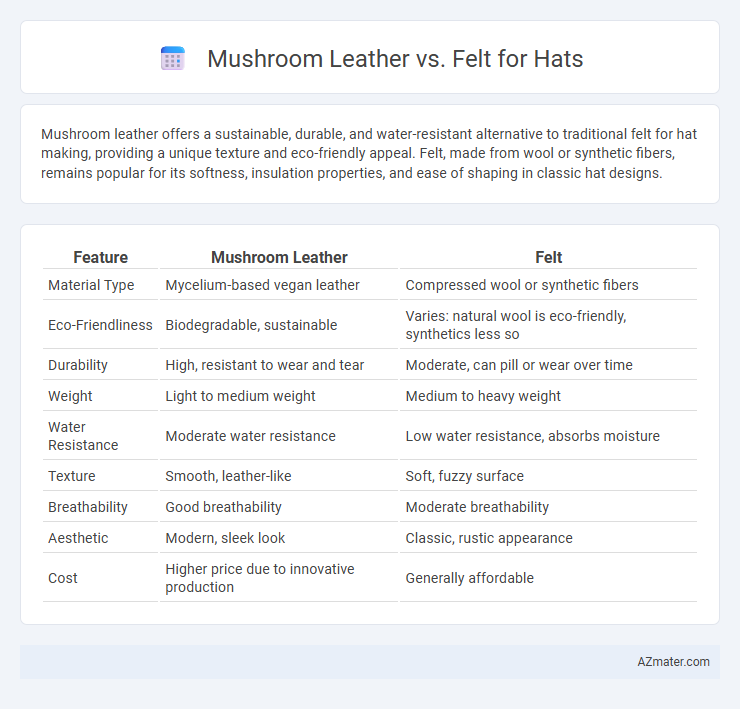Mushroom leather offers a sustainable, durable, and water-resistant alternative to traditional felt for hat making, providing a unique texture and eco-friendly appeal. Felt, made from wool or synthetic fibers, remains popular for its softness, insulation properties, and ease of shaping in classic hat designs.
Table of Comparison
| Feature | Mushroom Leather | Felt |
|---|---|---|
| Material Type | Mycelium-based vegan leather | Compressed wool or synthetic fibers |
| Eco-Friendliness | Biodegradable, sustainable | Varies: natural wool is eco-friendly, synthetics less so |
| Durability | High, resistant to wear and tear | Moderate, can pill or wear over time |
| Weight | Light to medium weight | Medium to heavy weight |
| Water Resistance | Moderate water resistance | Low water resistance, absorbs moisture |
| Texture | Smooth, leather-like | Soft, fuzzy surface |
| Breathability | Good breathability | Moderate breathability |
| Aesthetic | Modern, sleek look | Classic, rustic appearance |
| Cost | Higher price due to innovative production | Generally affordable |
Introduction: Mushroom Leather vs Felt Hats
Mushroom leather offers a sustainable and eco-friendly alternative to traditional felt in hat making, combining durability with a unique organic texture. Felt hats, crafted from animal fibers or synthetic materials, provide a classic, soft, and warm option favored for their moldability and breathability. Comparing mushroom leather and felt highlights the benefits of innovative plant-based materials against established textile craftsmanship in fashion accessories.
Material Origins: Understanding Mushroom Leather and Felt
Mushroom leather, derived from mycelium--the root structure of fungi--offers a sustainable alternative to traditional animal leather, emphasizing eco-friendly material origins rooted in fungal biomass. Felt, traditionally made from natural fibers such as wool or synthetic materials, is created through a matting and pressing process, highlighting its versatility and historical use in textile crafts. Understanding these material origins reveals that mushroom leather provides innovative, biodegradable options while felt maintains a legacy of durability and insulation from fibrous sources.
Sustainability and Environmental Impact
Mushroom leather, derived from mycelium, offers a sustainable alternative to traditional hat materials due to its biodegradability and low resource consumption during production, significantly reducing carbon emissions compared to animal leather. Felt, typically made from wool or synthetic fibers, raises sustainability concerns through intensive water use, methane emissions from sheep, and microplastic pollution associated with synthetic variants. Choosing mushroom leather supports circular fashion initiatives by minimizing waste and reliance on animal agriculture, promoting eco-friendly hat manufacturing with a smaller environmental footprint.
Durability and Longevity Comparison
Mushroom leather, made from mycelium fibers, offers superior durability compared to traditional felt, resisting wear and tear more effectively over time. Felt hats, typically composed of wool or synthetic fibers, tend to show signs of fraying and compression with prolonged use. The natural resilience and water resistance of mushroom leather contribute to a longer lifespan, making it a more sustainable choice for high-quality hats.
Comfort and Breathability
Mushroom leather offers superior breathability compared to felt due to its natural, porous structure, allowing better air circulation and moisture regulation. Felt, made from densely matted fibers, tends to trap heat and moisture, which can reduce comfort during extended wear. For hats, mushroom leather provides a lightweight, flexible feel that enhances overall comfort and keeps the head cooler in warm conditions.
Aesthetic Considerations: Texture and Appearance
Mushroom leather offers a smooth, supple texture with a natural, earthy appearance that enhances the sophistication and modern aesthetic of hats. Felt provides a dense, soft surface with a matte finish, delivering a classic, traditional look that suits vintage and formal styles. The choice between mushroom leather and felt depends on desired visual impact, where mushroom leather brings contemporary elegance and felt ensures timeless charm.
Care and Maintenance Differences
Mushroom leather requires gentle cleaning with a damp cloth and occasional conditioning using plant-based oils to maintain its flexibility and prevent cracking, while felt hats benefit from regular brushing with a soft-bristle brush to remove dust and prevent matting. Mushroom leather is more resistant to water but should be protected from prolonged exposure to moisture to avoid damage, whereas felt hats are susceptible to water stains and typically need reblocking after heavy moisture exposure. Proper storage for mushroom leather involves keeping it in a cool, dry place away from direct sunlight, whereas felt hats maintain shape best when stored on a hat stand or stuffed with tissue to preserve form.
Cost Analysis: Affordability and Value
Mushroom leather offers a sustainable yet premium cost profile, often priced higher due to its innovative production methods and eco-friendly appeal. Felt, traditionally made from wool or synthetic fibers, remains more affordable and widely accessible, making it a popular choice for budget-conscious consumers. Evaluating long-term value, mushroom leather provides durability and unique aesthetics that can justify its initial higher investment compared to felt's cost-effective but less durable nature.
Ethical Factors: Animal-Free vs Traditional Materials
Mushroom leather offers an ethical advantage over felt by being entirely animal-free, derived from sustainable fungal mycelium that reduces environmental impact compared to traditional materials sourced from wool or animal hides. Felt production often involves animal cruelty concerns and higher land and water use, whereas mushroom leather supports cruelty-free fashion with biodegradable properties. Choosing mushroom leather aligns with ethical consumerism focused on reducing animal exploitation and promoting eco-friendly alternatives in hat manufacturing.
Future Trends in Hat Materials
Mushroom leather represents a sustainable and innovative alternative to traditional felt in hat materials, offering biodegradability and a lower environmental impact. Advances in mycelium cultivation technologies enable scalable production, positioning mushroom leather as a key player in eco-friendly fashion trends. As consumer demand shifts towards cruelty-free and renewable resources, mushroom leather is set to revolutionize the hat industry by combining durability with sustainability.

Infographic: Mushroom leather vs Felt for Hat
 azmater.com
azmater.com